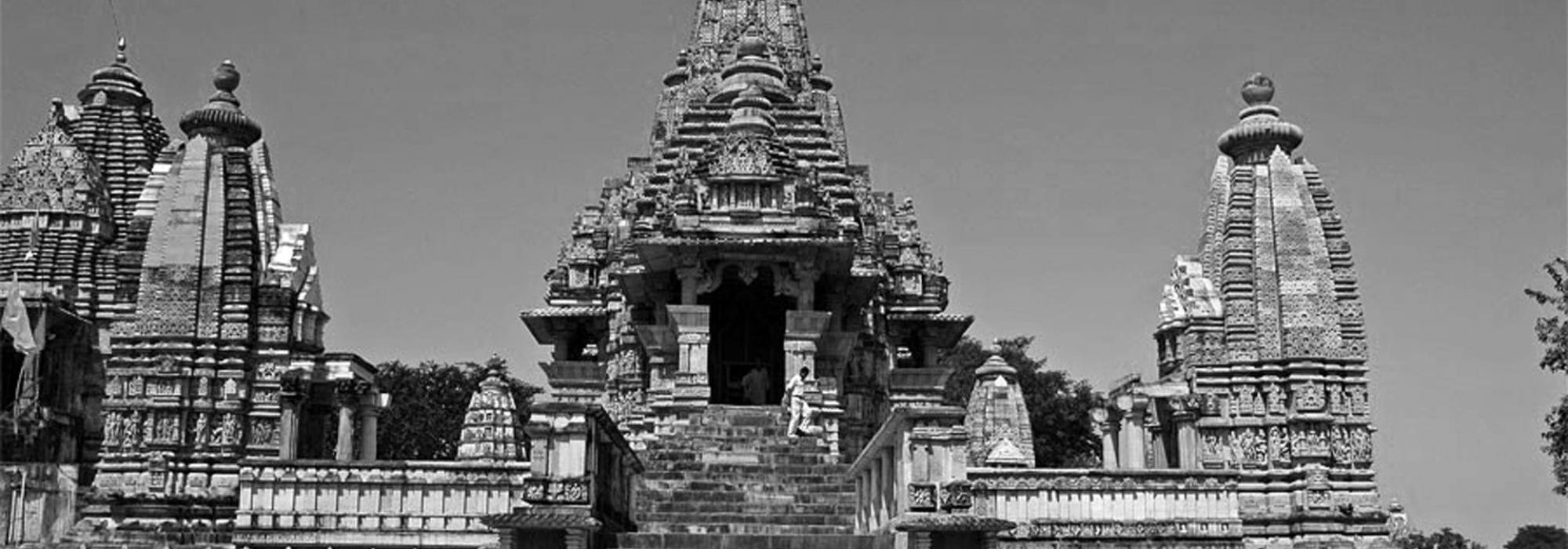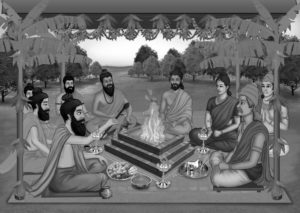Bhīṣma, Yudhiṣṭhira, and Kṛṣṇa have been portrayed as the noble characters in the Mahābhārata. Among these, Yudhiṣṭhira looks upon Kṛṣṇa as an elder brother and a guide to their family; and as for Bhīṣma, he looks at Kṛṣṇa as a devata. Therefore, in the poet’s vision, in the whole of the Mahābhārata, Kṛṣṇa is the noblest of them all, and the most worthy of worship. It is not surprising that fantastic tales have been weaved around his character. As mentioned earlier, his influence is the strongest in the epic. The opinion “भगवान् वासुदेवश्च कीर्त्यतेऽत्र सनातनः”—here, the Primordial and Eternal Being, Vāsudeva is eulogised—seems to be correct. So the (Mahā-) Bhārata is Bhāgavata too. The pastimes of his childhood are also hinted beautifully in the Mahābhārata. Bhīṣma narrates them in great detail, but many believe that these portions are interpolated. It is for that reason that the Vacana-bhārata only delineates Śiśupāla’s suggestive retelling of the same. Having heard and eulogised the greatness of Kṛṣṇa in the Mahābhārata and yet not being satiated by his infinite charm perhaps, the Harivaṃśa, the Bhāgavata and other texts were born. [Bhāgavata 1-15, Nārada says ‘O, Maharṣi Vyāsa, in the Mahābhārata, as much as you have dealt with the details of the puruṣārthas of dharma, artha, and kāma, you have not dealt with the greatness of Bhagavān Kṛṣṇa.] Similarly, in the Rāmopākhyāna, the story of the epic Rāmāyaṇa is also contained. We have seen earlier that there are several Vedic and Purāṇic upākhyānas (sub-stories) in the epic. Since all these are included in the Mahābhārata, it has become a greatly respected work; regardless of social background, age, or gender, all Hindus rooted in their tradition [i.e., all those who come under the broad canopy of the Sanātana-dharma, which includes Hindus, Jains, Buddhists, Sikhs, etc.] hold this epic in high regard.
The Mahābhārata contains references to Devāyatana or Devatāyatana (ancient form of temples). But it is difficult to infer if these were akin to the temples that we are familiar with today – i.e., temples with a gopura, garbha-gṛha, an installed image of a deity being worshipped, etc. While the epic contains detailed descriptions of palaces and pavilions (maṇṭapas) built for svayaṃvara [occasion when a woman chooses her husband among many suitors], it is likely that there would have been descriptions of temples too, had they existed. We learn that people worshipped deities when they were victorious or when they were overjoyed. But we neither know the manner and mode of worship nor the deities propitiated. Therefore, ‘devatāyatana’ seems to refer merely to a sacred place or region where the deities resided [and perhaps not the temples as we know them today]. Even in the case of tīrtha-kṣetras, their greatness was more due to the ṛṣis who lived there and the yāgas that were conducted there, less due to the concrete structure such as a temple or the vigraha (roughly translated as ‘idol’ or ‘image’) of a deity. It is said that Karṇa performed japa to the sun deity, Sūrya. In today’s sandhyāvandanam, the offering of arghya, paying respects to Sūrya and Gāyatrī-mantra-japa constitute its core elements. Recitation of the Gāyatrī mantra is equivalent of Sun-worship. Even the sūrya-namaskāra is widely held to be a reliever of all kinds of physical ailments and Viṣṇu is also a form of Sūrya.
In today’s world, yajña and yāgas have lost prominence. There are hardly a few people who continue to maintain the śrautāgni [i.e. the three fires, which are used in performing the śrauta rites]. It is true that we propitiate Indra, Agni, Varuṇa, and other deities to some extent in other minor rituals such as the havanas and homas. However, they have lost the importance they had earlier; there are hardly temples and monuments raised in their honour; that honour is being now given to Śiva, Viṣṇu, and other deities. The only regularly performed Vedic rituals today are the sandhyāvandanam, Gāyatrī-mantra-japa, and Brahma-yajña. These too are going out of practise. The various forms and avatāras of Kṛṣṇa, Śiva, and Rāma; the deities associated with their families; worship and associated with them; mūrti-pūja conducted in homes and temples and the various vratas that are observed through the year – to a large extent, these are in practise particularly among women. [Rāma’s worship probably came into being around eleventh century CE – R G Bhandarkar: Collected Works, Volume IV: Vaishnavism, Saivism and Minor Religious Systems, p. 66].
Pilgrimages to sacred places like Kashi and Rameswaram are equally important in the lives of many. The trip to these places is not as difficult as it was in the olden days. There are several facilities for travellers today. Therefore, it is comfortable, joyful, and convenient for the rich. However, in several such travels, there is a possibility of calamities due the excessive crowd at one place, leading to loss of life and property. [In the 1954 Kumbha Mela, 253 women, 49 men, and 14 children, totally 316 people died in the stampede that resulted due to the excessive crowd]. Even on a daily basis, the trouble posed by Paṇḍas and Purohitas at these places puts off many people. Looking at all this, it seems like we forget the simple fact that is present within us, and look all around for divinity; it is like losing the rice while clinging on to the husk. We seem to be after the pompous and ostentatious external arcana, rather than sāttvic internal tapas. What is it that catches us in a temple after all? Riches such as gold, silver, ornaments, light, embellishments, crowd, and chaos!
So we must always remember the saying ‘deho devālayaḥ prokta, jīvo devassanātanaḥ’ [The body is the abode of the divine and the human being is eternally divine] and tread the path of ātma-guṇas [human qualities, fundamental traits; see Gautama-dharma-sūtra 1.8.24] like compassion, forgiveness, cleanliness, and freedom from jealousy, thus leading to the overall development of personality. This does not mean that we must give up the cultural tradition and social practices that have come down to us; they did not come into being without reason in the past; and if the reason is no longer relevant, the practices slowly disappear; this is perhaps how the various Vedic yajñas and yāgas [For example, the Aśvamedha-yajña] and the multiple saṃskāras have gone obsolete. It is only in the Indian tradition that we find the magnanimous idea that the supreme Brahman is recipient of all worship, irrespective of the name of the deity, or the modes and means of worship. We must keep this in mind and develop compassion towards other traditions and opinions. As the practice and adherence to dharma is primarily for the evolution of the individual personality, it is better to practice it at the individual level, rather than making a show of it at the societal level. It may be said that in today’s world, that is precisely what is needed. Even in the past, in the name of varied opinions and customs, there have been several quarrels, debates, and fights. People have taken refuge in such quarrels and the so-called dharmādhikāris have built institutions and have shaken the authority of kings. Even today [c. 1950], in Europe, the church is given a lot of importance. Some governments did away with the church as they found it to be irrelevant as well as perpetuating atrocities and injustice. Nevertheless it is not easy for man to give up their religious spirit, preoccupation with divinity, and their blind devotion – even in the absence of churches, temples, and religious preachers. He will think of the divine at least when he is in trouble. The person who desires to know about the universe and the one who knows about the universe – both will go after the Divine Spirit, the Supreme Essence. There are people who take refuge in dharma both for worldly and other worldly desires. This is said in the Gītā:
चतुर्विधा भजन्ते मां
जनाः सुकृतिनोऽर्जुन।
आर्तो जिज्ञासुरर्थार्थी
ज्ञानी च भरतर्षभ॥
– Bhagavadgītā 7.16
“Arjuna, four kinds of sincere people worship me: a seeker of wealth, a person in distress, a seeker of wisdom, and a wise person.”
It is better to adhere to the traditional practises to the best of the abilities of an individual rather than abandoning them completely. While we are no different from others in the world in all other matters, ultimately all that remains is not a deity with name and form, nor a sacred text, but instead, the essence contained in them, that is the ātma-guṇa. If there is anything that can be called a universal dharma, then the ātma-guṇas have to be preeminent in it. [“…by mutual sympathy and goodwill, all differing symbolisms, theories, mythologies and aspirations, which in past centuries have been helpful to peoples in widely separated portions of the globe, may find their reconciliation in a unanimity of religious ideals, which shall transcend all those hitherto current, and command acceptance from the conscience of universal man.” – E.P Rice: Preface to The Mahabharata: Analysis and Index].
In the Gautama-dharma-sūtra, a work of the period of the Mahābhārata and one of the older dharmasūtra texts, it is said that brāhmaṇas have forty saṃskāras [among these, a few had already become obsolete during the author’s time; today only a few have remained in name. The forty saṃskāras are: garbhādhāna; puṃsavana; sīmantonnayana; jātakarma; nāmakaraṇa; annaprāśana; caula/cūḍākaraṇa; upanayana – and along with it, the vows related to Vedic studies: prājāpatya-saumya-āgneya-vaiśvadeva; samāvartana; snāna; vivāha and the five great yajñas that householders have to perform daily (the offering to deva-pitṝ-brahma-manuṣya-bhūta); the seven domestic yajñas carried out in the gṛhāgni: aupāsana, vaiśvadeva, parvaṇa, aṣṭakāśrāddha, śrāvaṇī, agrahāyaṇī, caitrī, and aśvayuji; the seven haviryajñas carried out in the tretāgni: agnyādheya, agnihotra, darśapūrṇamāsa, cāturmāsya, agrayaṇa, nirūḍhapaśubandha, and sautrāmaṇi; the seven somayajñas carried out in the tretāgni: agniṣṭoma, atyagniṣṭoma, ukthya, ṣoḍaśī, vājapeya, atirātra, and aptoryāma. According to the list provided in the Gautama-dharma-sūtra, antyeṣṭi is not included.] In that context, the Gautama-dharma-sūtra lists out eight ātma-guṇas –
- compassion towards all sentient beings
- fortitude
- freedom from jealousy
- cleanliness of body and mind
- focused hard work
- noble thoughts and good conduct
- freedom from pettiness
- freedom from excessive desires
Gautama opines that even if a few saṃskāras are left out, it does not matter as long as the ātma-guṇas are adhered to. This applicable not merely to brāhmaṇas, but to people of all social classes as well, and all the regions of the world. [It is applicable across spatio-temporal boundaries]. The ‘sārvabhauma-mahāvrata’ of the Yoga-sūtra and ‘śīla’ of the Mahābhārata, both, in essence speak of the ātma-guṇas. The immense popularity of Buddhism, Ramakrishna Mission, and the others among the masses is mainly due to their adherence to this eternal dharma of the Brahman, and their emphasis on universally applicable conduct. The great people born in any part of the world ultimately speak of these same values and traits.
The Mahābhārata is the story of kṣatriyas who tread the path of dharma; therefore, the epic mostly contains matters and opinions of the kṣatriyas and brāhmaṇas. The Anuśāsana-parva gives a detailed overview of the four varṇas as well as the four āśramas that were prevalent in those times. Its essence can be seen in the Bhagavadgītā (18.42-44). In those times, since all the people sincerely embraced the principles of varṇa and āśrama, society was as stable as water in a pot. People believed that it was enough if they occupied themselves doing the kind of work aligned to their temperament; therefore the dharma of varṇa and āśrama had prominence.
To be continued.
Thanks to Śatāvadhāni Dr. R Ganesh for his astute feedback.


















































